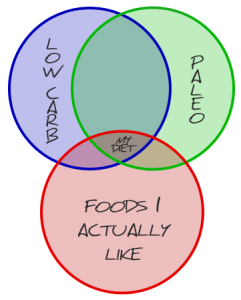When I started searching for protein bar recipes one of the first ones I came across was this recipe for chocolate coconut bars. It really is as good as it sounds, but it has four problems:
- whipping cream
- powdered milk
- whey protein
- erythritol
The solution to the powdered milk was easy enough. The author had clarified in a comment that the purpose of it was to turn the chocolate into a milk chocolate, and since I prefer dark chocolate anyway, I left it out.
The whipping cream was less straightforward. There are plenty of soy- or nut-based milk substitutes, but few that function as whipping cream or even just “cream” (at least ones that don’t have added sugar). I found it works to use MimicCreme, but the recipe only calls for a quarter cup and then we’re left with a (nearly) whole opened carton of the stuff that has to be used in seven days. Next I tried plain goat milk yogurt, which also works, but then I cut out any and all dairy protein so that went as well.
It probably took longer than it should have for me to land on coconut cream. It seems obvious now, but that’s because I’m substituting coconut milk or coconut cream in just about everything.
The advantage coconut cream has over the other things I tried is that it will actually whip up; maybe not as well as whipping cream, but enough to make a noticeable difference in the texture of the fudge.
The whey protein: that obviously had to go when I did the dairy purge. My substitute is egg protein powder.
Different protein powders behave differently so you can’t just swap one for another and expect the recipe to turn out the same, but in this case it worked all right. Maybe because it isn’t cooked. The only thing to watch for is that you want to use about half the amount of egg protein powder that you would of whey protein powder to get the same amount of protein.
As for the erythritol, it’s a sugar alcohol. And while it’s purported to be the least offensive of the bunch, it can still cause gastrointestinal problems. (If you eat too much. Which is easy to do with these, because they’re yummy.)
The advantage sugar alcohols have over other sweeteners like stevia is that they behave more like sugar. What that means here is that the erythritol adds body to the fudge. Without it the fudge comes out very dense—not necessarily a bad thing, but noticeable.
With all that out of the way, this is my version of the recipe, dairy (lactose and whey) and sugar alcohol free. I also usually use a hand mixer instead of the food processor, because I like the texture I get with that better, but the food processor works too and is certainly quicker. (I left in the butter, which is primarily milk fat and so not an issue for me, but you can leave it out and substitute an extra tablespoon of coconut oil.)
Serves: 26 squares
* Percent Daily Values are based on a 2,000 calorie diet. Your daily values may be higher or lower depending on your calorie needs.
Catjester
Ingredients
Instructions
Nutrition Facts
Low-Carb Chocolate Protein Fudge
Amount Per Serving:
Calories
61.4
% Daily Value*
Total Fat
5.0
7.7%
Saturated Fat
0
Trans Fat
Cholesterol
0
Sodium
0
Total Carbohydrate
1.1
0.4%
Dietary Fiber
0
Sugars
Protein
3.0
Vitamin A
Vitamin C
Calcium
Iron









Recent Comments